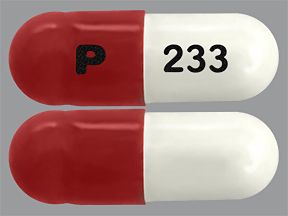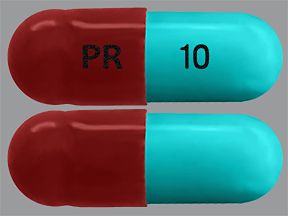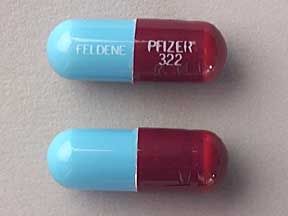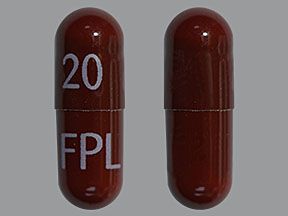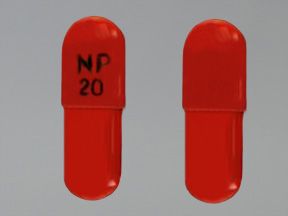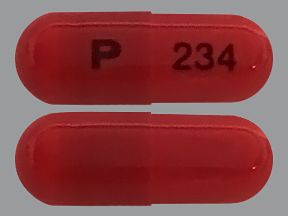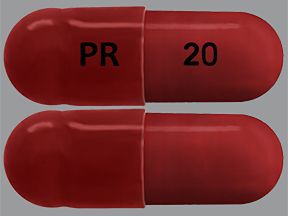- Piroxicam oral capsule is available as a brand-name drug and a generic drug. Brand name: Feldene.
- Piroxicam comes only as a capsule you take by mouth.
- Piroxicam oral capsule is used to treat rheumatoid arthritis and osteoarthritis.
FDA warning
- This drug has black box warnings. These are the most serious warnings from the Food and Drug Administration (FDA). Black box warnings alert doctors and patients about drug effects that may be dangerous.
- Heart disease risk warning: Piroxicam belongs to a drug class called nonsteroidal anti-inflammatory drugs (NSAIDs). NSAIDs may increase your risk of serious heart-related problems, such as heart attack and stroke. Your risk may be higher if you’re taking this drug long term or at high doses, or if you already have heart problems or risk factors for heart disease, such as high blood pressure.
- Warning about ulcers and stomach bleeding that can result in death: Piroxicam can cause ulcers and bleeding in your stomach and intestines. This can happen at any time during treatment and may occur without symptoms. These conditions can be fatal. You’re at higher risk of these problems if you’re older than 65 years.
- Coronary artery bypass graft surgery warning: Don’t take piroxicam for pain after coronary artery bypass graft surgery. Doing so may increase your risk of a heart attack or stroke.
Other warnings
- High blood pressure warning: Piroxicam can cause high blood pressure or make your high blood pressure worse. You may need to check your blood pressure level often while taking this drug.
- Water retention and swelling warning: If you have water retention issues or heart problems, watch for symptoms of water retention when taking piroxicam.
- Asthma warning: Piroxicam can cause an asthma attack. If you have asthma that can be triggered by aspirin, don’t take piroxicam. It could also trigger an asthma attack.
Piroxicam is a prescription drug. It comes only as an oral capsule.
Piroxicam is available as the brand-name drug Feldene. It’s also available in a generic form. Generic drugs usually cost less than the brand-name version. In some cases, they may not be available in every strength or form as the brand-name drug.
Why it’s used
Piroxicam is used to treat symptoms of osteoarthritis and rheumatoid arthritis.
How it works
It isn’t completely understood how piroxicam works. It belongs to a class of drugs called nonsteroidal anti-inflammatory drugs (NSAIDs). NSAIDs help reduce pain, inflammation, and fever.
NSAIDs may help reduce swelling by lowering levels of prostaglandin, a hormone-like substance that usually causes inflammation.
Piroxicam oral capsule doesn’t cause drowsiness, but it can cause other side effects.
More common side effects
The more common side effects that can occur with piroxicam include:
- diarrhea
- dizziness
- headache
- heartburn
Serious side effects
Call your doctor right away if you have serious side effects. Call 911 if your symptoms feel life-threatening or if you think you’re having a medical emergency. Serious side effects and their symptoms can include the following:
- Allergic reaction. Symptoms can include:
- skin rash
- itching or hives
- swelling of your face, lips, or tongue
- Heart attack or stroke. Symptoms can include:
- chest pain
- shortness of breath
- weakness on one side of your body
- slurred speech
- Kidney damage. Symptoms can include:
- decreased urination
- swelling in your arms, legs, hands, or feet
- Heart failure. Symptoms can include:
- unusual weight gain
- swelling in your arms, legs, hands, or feet
- Stomach problems, such as ulcers and bleeding. Symptoms can include:
- stomach pain or upset stomach
- black, tarry stools
- vomiting blood
- Liver problems. Symptoms can include:
- yellowing of your skin or the whites of your eyes
- flu-like symptoms, such as body aches, fever, nausea, and vomiting
- tiredness
- pain in the upper part of your stomach
- itching
- Skin reactions. Symptoms can include:
- reddening, blistering, or peeling skin
Disclaimer: Our goal is to provide you with the most relevant and current information. However, because drugs affect each person differently, we cannot guarantee that this information includes all possible side effects. This information is not a substitute for medical advice. Always discuss possible side effects with a healthcare provider who knows your medical history.
Piroxicam oral capsule can interact with other medications, vitamins, or herbs you may be taking. An interaction is when a substance changes the way a drug works. This can be harmful or prevent the drug from working well.
To help avoid interactions, your doctor should manage all of your medications carefully. Be sure to tell your doctor about all medications, vitamins, or herbs you’re taking. To find out how this drug might interact with something else you’re taking, talk to your doctor or pharmacist.
Examples of drugs that can cause interactions with piroxicam are listed below.
Nonsteroidal anti-inflammatory drugs
Taking piroxicam with other NSAIDs may increase side effects, including stomach pain. Examples of other NSAIDs include:
- aspirin
- ibuprofen
- naproxen
Disease-modifying anti-inflammatory drug
Taking methotrexate with piroxicam can lead to dangerous levels of methotrexate in your body. This may cause side effects such as nausea, vomiting, diarrhea, mouth sores, fever, and hair loss.
Blood pressure drugs
Taking certain blood pressure drugs with piroxicam might make those drugs not work as well. Examples of these drugs include:
- angiotensin-converting enzyme (ACE) inhibitors
- diuretics (water pills)
Anticoagulant/blood thinner
Taking warfarin with piroxicam increases your risk of stomach and intestinal bleeding.
Disclaimer: Our goal is to provide you with the most relevant and current information. However, because drugs interact differently in each person, we cannot guarantee that this information includes all possible interactions. This information is not a substitute for medical advice. Always speak with your healthcare provider about possible interactions with all prescription drugs, vitamins, herbs and supplements, and over-the-counter drugs that you are taking.
This drug comes with several warnings.
Allergy warning
Piroxicam can cause a severe allergic reaction. Symptoms may include:
- shortness of breath or trouble breathing
- chest pain
- weakness in one part or side of your body
- trouble speaking
- swelling of your face or throat
If you develop these symptoms, call 911 or go to the nearest emergency room.
Don’t take this drug again if you’ve ever had an allergic reaction to it. Taking it again could be fatal (cause death).
Alcohol interactions warning
Combining piroxicam and alcohol increases your risk of ulcer or stomach bleeding.
Warnings for people with certain health conditions
For people with asthma: Piroxicam can cause an asthma attack. If you have asthma that can be triggered by aspirin, you shouldn’t use piroxicam. It may have the same effect as aspirin.
For people with stomach ulcers or bleeding: This medication increases your risk of bleeding, ulcers, and tears (perforation) in the esophagus, stomach, and intestines. If you have a history of ulcers or stomach or intestinal bleeding and take piroxicam, watch for symptoms of these conditions. Symptoms include stomach pain, black, tarry stools, and vomiting blood. You’re at higher risk if you smoke, use alcohol, or are older than 65 years. Other factors that can increase your risk of bleeding include smoking and taking piroxicam with certain other medications, including antiplatelet drugs (such as aspirin), corticosteroids, selective serotonin reuptake inhibitors, and serotonin and norepinephrine reuptake inhibitors.
For people with kidney disease: Piroxicam can cause kidney damage if you use it for a long time. If you have serious kidney disease, you shouldn’t use this drug.
For people with high blood pressure: Piroxicam can cause high blood pressure or make your high blood pressure worse. You may need to check your blood pressure level often while taking piroxicam.
Warnings for other groups
For pregnant women: Piroxicam is a category C pregnancy drug. That means two things:
- Research in animals has shown adverse effects to the fetus when the mother takes the drug.
- There haven’t been enough studies done in humans to be certain how the drug might affect the fetus.
Avoid taking piroxicam during your third trimester of pregnancy. It may harm your pregnancy.
Talk to your doctor if you’re pregnant or planning to become pregnant.
For women who are breastfeeding: Piroxicam passes through breast milk and may cause side effects in a child who is breastfed. It’s not recommended to breastfeed while taking this medication.
For seniors: If you’re older than 65 years, your body may process this drug more slowly. Your doctor may start you on a lowered dosage so that too much of the drug doesn’t build up in your body. Too much of the drug in your body can be dangerous.
For children: The safety and effectiveness of piroxicam haven’t been established in children younger than 18 years.
All possible dosages and forms may not be included here. Your dose, form, and how often you take it will depend on:
- your age
- the condition being treated
- how severe your condition is
- other medical conditions you have
- how you react to the first dose
Drug forms and strengths
Generic: Piroxicam
- Form: oral capsule
- Strengths: 10 mg and 20 mg
Brand: Feldene
- Form: oral capsule
- Strengths: 10 mg and 20 mg
Dosage for osteoarthritis
Adult dosage (ages 18 years and older)
The typical dosage is 20 mg taken once per day. You may take 10 mg two times per day in evenly spaced doses.
Child dosage (ages 0-17 years)
Dosage for children than 18 years hasn’t been established.
Dosage for rheumatoid arthritis
Adult dosage (ages 18 years and older)
The typical dosage is 20 mg taken once per day. You may take 10 mg two times per day in evenly spaced doses.
Child dosage (ages 0-17 years)
Dosage for children younger than 18 years hasn’t been established.
Disclaimer: Our goal is to provide you with the most relevant and current information. However, because drugs affect each person differently, we cannot guarantee that this list includes all possible dosages. This information is not a substitute for medical advice. Always speak with your doctor or pharmacist about dosages that are right for you.
Piroxicam oral capsule is used for short-term treatment. It comes with risks if you don’t take it as prescribed.
If you stop or miss doses: If you stop taking this medication, miss doses, or don’t take it on schedule, your symptoms of arthritis may get worse.
If you take too much: If you take too much piroxicam, you may experience:
- fatigue
- drowsiness
- nausea
- vomiting
- stomach pain
- stomach bleeding
In rare cases, taking too much can cause dangerous allergic reactions, high blood pressure, kidney failure, trouble breathing, or coma.
If you think you’ve taken too much of this drug, call your doctor or local poison control center.
If your symptoms are severe, call 911 or go to the nearest emergency room right away.
What to do if you miss a dose: If you miss a dose, take it as soon as you remember. However, if it’s just a few hours until your next dose, wait and take a single dose at the usual time. Never try to catch up by taking two doses at once. This could result in dangerous side effects.
How to tell if the drug is working: You should have reduced arthritis pain.
Keep these considerations in mind if your doctor prescribes piroxicam for you.
General
- You can take piroxicam with food to reduce stomach irritation.
- This is an oral capsule, so it shouldn’t be cut or crushed.
Storage
- Store this drug at a temperature between 59°F and 86°F (15°C and 30°C).
- Keep the container tightly closed.
- Protect this medication from light.
Refills
A prescription for this medication is refillable. You should not need a new prescription for this medication to be refilled. Your doctor will write the number of refills authorized on your prescription.
Travel
When traveling with your medication:
- Always carry your medication with you. When flying, never put it into a checked bag. Keep it in your carry-on bag.
- Don’t worry about airport X-ray machines. They can’t harm your medication.
- You may need to show airport staff the pharmacy label for your medication. Always carry the original prescription-labeled container with you.
- Don’t put this medication in your car’s glove compartment or leave it in the car. Be sure to avoid doing this when the weather is very hot or very cold.
Clinical monitoring
Your doctor may do tests to check your health and make sure this drug is working for you. These tests include:
- blood test
- kidney function test
- liver function test
Prior authorization
Many insurance companies require a prior authorization for this drug. This means your doctor will need to get approval from your insurance company before your insurance company will pay for the prescription.
There are other drugs available to treat your condition. Some may be more suitable for you than others. Talk to your doctor about possible alternatives.
Disclaimer: Healthline has made every effort to make certain that all information is factually correct, comprehensive, and up-to-date. However, this article should not be used as a substitute for the knowledge and expertise of a licensed healthcare professional. You should always consult your doctor or other healthcare professional before taking any medication. The drug information contained herein is subject to change and is not intended to cover all possible uses, directions, precautions, warnings, drug interactions, allergic reactions, or adverse effects. The absence of warnings or other information for a given drug does not indicate that the drug or drug combination is safe, effective, or appropriate for all patients or all specific uses.



